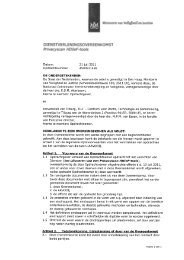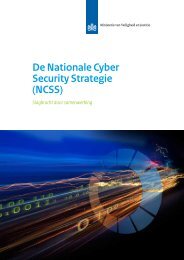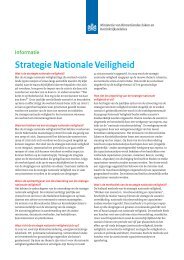Countering Violent Extremist Narratives
Countering Violent Extremist Narratives
Countering Violent Extremist Narratives
- No tags were found...
Create successful ePaper yourself
Turn your PDF publications into a flip-book with our unique Google optimized e-Paper software.
empirical evidence to gauge its micro-causal mechanisms: We know very little about the distal andproximate conditions that explain why any given individual happens to be more receptive to any oneelement of the narrative than another. In short, we have some idea who is likely to be more (or less) proneto the narrative: but not knowing why the narrative has traction with any given individual makes it difficultto devise an effective counter-narrative strategy. Nevertheless, the empirical evidence cited here is sufficientto conclude that when it comes to counter-narratives, one size does not fit all.Global Jihad action in the pyramid modelFor decades psychologists have studied the relation between beliefs and feelings (cognition and attitude)and action (behaviour). There is no simple generalisation to be made about this relation. Under somecircumstances, beliefs and feelings are good predictors of action (in a voting booth, for instance) and inother circumstances beliefs and feelings are weak predictors of action (when strong social norms runcounter to an individual’s attitude, for instance). When action consistent with beliefs and feelings is costly(such as committing oneself to a suicide bombing), the gap between belief and behaviour is likely to belarge.This also seems to be the situation for the Global Jihad narrative: the opportunity cost of believing in a waron Islam and feeling that suicide attacks are justified in defence of Islam is relatively low; action in defenceof Islam is disproportionately costly in time, energy, and, at least in Western countries, risk of incarcerationor death.The gap between belief and action is evident in the contrast between polling data and security reports inthe U.K., where 5% of adult Muslims saw reported suicide attacks as justified but only several hundredterrorism-related arrests have been made since 9/11. The 5% of Muslims projects to about 50,000 of theroughly one million adult Muslims in the U.K., indicating that only about 200 of 50,000 U.K. Muslims haveacted on their beliefs in the Global Jihad narrative. The difficulty for security forces is finding the needlein the haystack: the one among hundreds who will act on belief in even the most extreme aspects of theGlobal Jihad narrative.A similar situation exists in the U.S. According to the 2007 Pew poll of an estimated 2.3 million U.S.Muslims, 8% find suicide attacks justified often or sometimes, but fewer than a hundred terrorism-relatedarrests have been made since 9/11.The gap between the Global Jihad narrative and Global Jihad violence, at least in Western countries,indicates the need for another pyramid model, the pyramid of action (Figure 2). Here the base includesall Muslims who are politically inert, whatever their beliefs or feelings. The next higher level are activists,engaged in legal and nonviolent political action, although some may join in one or another part of theGlobal Jihad narrative. Hizb ut-Tahrir members, for instance, are legal activists in both the U.K. and in theU.S. (Hizb had its first national meeting in the U.S. in Chicago in July 2009), even though Hizb, like Osama,is striving to re-establish a supra-national caliphate. Higher yet are radicals, engaged in illegal politicalaction that may include violence. Finally, at the apex of the action pyramid are the terrorists, radicals whotarget lethal violence against civilians.InertActivistsRadicalsFigure 2. The action pyramidTerroristsIt is important to distinguish between non-violent and violent political behaviour, because, ultimately, itis the latter that is of primary concern for the purposes of public security. The former is of interest only ifthere is evidence that it presages the latter. For example, the movement for voting rights for women, andthe civil-rights movement militating for racial equality, were both considered radical and engaged in someillegal political action. With the benefit of hindsight, however, would we judge them as a liability or as anasset to the body politic?We believe that the borders between the levels of the action pyramid represent the most importanttransition points of radicalisation in action: from doing nothing to doing something; from legal politicalaction to illegal political action; and from illegal political action to killing civilians. It is important to beclear, however, that the action pyramid is neither a conveyor belt nor a stage theory in which an individualmust progress through each succeeding level in a linear fashion to become a terrorist. It is not necessary tobe an activist to become a radical, nor is it necessary to be involved in nonviolent radical action to move toviolent radical action.Mechanisms of radicalisationAny attempt at formulating a stage theory of radicalisation in action is contradicted by the multiplemechanisms of radicalisation identified at individual, group, and mass levels. The following mechanismsof radicalisation have been identified, mostly from case materials about terrorist groups and terroristindividuals. No claim is made that this is an exhaustive list: indeed, additional mechanisms have beenidentified since the first publication of this approach by McCauley and Moskalenko in 2008. 3Individual level1. Personal grievance. An individual is angry and seeks revenge for government action that harms self orloved ones. Personal grievance usually does not lead to action unless interpreted as part of some largergroup grievance. Chechen Black Widows revenging brothers and husbands killed by Russians are acommonly cited example.2. Group grievance. Identification with a group perceived as victims can radicalise an individual whohas not personally experienced any grievance. This includes ‘lone-wolf terrorism’ and ‘sudden jihad62 63
















